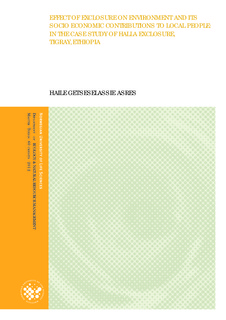| dc.description.abstract | Though exclosure is sound for degraded land rehabilitation, mainly due to lack of quantitative
environmental and socio-economical merits most exclosures are attributed negatively by local people
and hence their sustainability left at risk. This study was held to identify and quantify effect of Halla
exclosure on environment and its socio-economic contribution to local community at Kebelle
Aynibrkekein, Woreda Degua Tembien,Tigray North Ethiopia. To do this, two mountains: closed and
non-closed were selected. To measure important parameters of trees and shrubs, herbs and grasses, 8
plots having 10*10m, 4*4m and 1*1m (nested each other) were taken respectively in each mountain.
And to assess actual contribution to the local people, 16 households under the closed and 22 under
the non-closed were interviewed. On top of this, group discussion was held with focus group.
Accordingly, 10 trees & shrubs (Shannon diversity index [H] =1.695934422) representing 93
individuals and 11 herbs representing 173 individual were found in the sample plots of the closed
whereas 5 trees & shrubs (H =1.241125184) representing 41 individual and 7 herbs representing 149
individual were found in the non-closed. Height structure of trees and shrubs at the closed seems like
bell shaped being most individuals concentrated to 1-2m while at the non-closed seems like inverted J
shape being most individuals concentrated to less than 0.5m. Both the closed and the non-closed
areas have inverted J shape diameter distribution but in the non-closed, maximum diameter were
limited to less than 10cm while in the closed the range stretched up to 15cm. The closed area was
significantly different over the non-closed in terms of tree and shrubs moist biomass, oven dry
biomass, carbon dioxide sequestration, biomass of forage grass, and biomass of thatching grass
(p<0.05) But not significantly different in terms of herbs moist biomass, oven dry biomass and carbon
dioxide sequestration, trees and shrubs canopy coverage, herbs canopy coverage, honey bee flora and
cactus fruit availability (p≥ 0.05). The closed area had 438108 kg moist biomass, 303600 oven dry
biomass and 669240 sequestrated carbon dioxide of trees and shrubs, and 165000kg forage grass,
and 132000kg thatching grass more than the non-closed area.
All (16) of the respondents under the closed mountain responded they were getting benefits from the
exclosure but under the non-closed, only 8 attributed the non-closed area is giving them some
benefits. May using fuel wood from the exclosure is illegal, all respondents, said, they do not use fuel
wood from it while 4 respondents under the non-closed said they fetch firewood from the non-closed.
4 respondents under the closure and 3 from the non-closed said their honey production is increasing
due to their respective areas but at the bottom of the exclosure there were two bee keeping enterprises
having 93 bee colonies producing about 4525kg/year but nothing was in the non-closed area. All of
the respondents under the exclosure said that they get forage and thatching grass from the exclosure
every year. About 13500kg and 64800kg forage and thatching grass respectively have been cut per
year by the local people but nothing under the non-closed. 10 from the closure and 2 from the nonclosure said their respective areas were contributing to their crop production and 80% of the
respondents under the closure said they got cactus fruits from it but nothing under the non-closed. 65
% respondents under the exclosure identified the exclosure is also giving them environmental
benefits such as decreasing erosion and increasing discharging potential of springs and wells
whereas under the non-closed area, all except 1 (he said it protects torrential wind) did not attributed
environmental benefits from it. In addition the respondents under the closure said they are getting
social benefits like job opportunity and they feel proud of having such closure. On contrary the
respondents under the non-closed were not attributed social benefits and hence some feel shame and
envy of the neighbor’s closure. Although the closure had environmental and socio-economical
potential and all the residents under it are getting benefits (though not optimum), most of them were
not happy with the benefits because of poor management and immediate benefit needs.50%
respondents decided to be free accessed for animals and fuel wood. In addition, most of them could
not quantify its benefits. Therefore, concerned body should interfere to manage appropriately and to
persuade especially to the pessimistic people by giving quantitative evidence of its merits over if it
were not closed and this study can be used as base. | no_NO |
